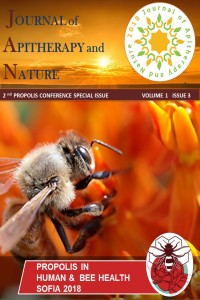Mechanistic Studies of Cytotoxicity Induced by a Portuguese Propolis Extract, Using Saccharomyces cerevisiae as Eukaryotic Cell Model
Öz
Propolis is a natural complex mixture
produced by honey bees (particularly Apis
mellifera L.) by collecting exudates from various plant sources.
Characterized by a plethora of chemicals, propolis is generally rich in
flavonoids, phenolic acids and terpene derivatives, bioactive compounds
associated to it’s antimicrobial, anti-inflammatory, antimutagenic and
antioxidant activities1. Previous work had shown that the ethanol
extract of a sample from the Portuguese region of Beira Alta exhibited unique
dual genotoxic and antigenotoxic effects using the yeast S. cerevisiae eukaryotic model2. In this work
we prepared two ethanol extracts (EE) of propolis samples from Pereiro (P) -
Beira Alta - collected in 2010 (P10.EE) and 2017 (P17.EE) to investigate the
mechanisms of cytotoxicity and genotoxicity using specific S. cerevisiae mutants. While P17.EE didn’t show any toxic effect,
yeast cells exposed to P10.EE showed a considerable decreased viability along
time, assessed by colony-forming units. Interestingly, the oxidative stress
response-defective mutant yap1 was
more resistant than the wild type, suggesting that this cytotoxic effect was
not mediated by oxidative stress. P.EE’s genotoxicity was also analysed by the
nucleus-cytosolic translocation of NHP6A protein, considered a marker of
necrosis. P10.EE induced NHP6A
protein translocation to the cytoplasm, observed by fluorescence microscopy,
suggesting that cytotoxicity of this extract was indeed mediated by necrosis.
Although P17.EE didn’t seem to induce necrotic cell death, both extracts
induced plasma membrane integrity loss, assessed by flow cytometry, using
propidium iodide as marker. As recently observed for erythroleukemic cells with
Brazilian propolis3, here we present the first evidence that also
Portuguese propolis have necrotic-mediated cytotoxicity in yeast cells.
Acknowledgments: This work is supported by: European Investment
Funds by FEDER/COMPETE/POCI– Operational Competitiveness and
Internationalization Programme, under Project POCI-01-0145-FEDER-006958 and
National Funds by FCT - Portuguese Foundation for Science and Technology, under
the project UID/AGR/04033/2013.
Anahtar Kelimeler
Kaynakça
- 1. Zabaiou N, Fouache A, Trousson A, Baron S, Zellagui A, Lahouel M, Lobaccaro JMA (2017) Chemistry and Physics of Lipids 207: 214-222.
- 2. Cruz M, Antunes P, Paulo L, Ferreira AM, Cunha A, Almeida-Aguiar C, Oliveira R (2016) RSC Advances 55: 49806-49816.
- 3 Bonamigo T, Campos JF, Alfredo TM, Balestieri JBP, Cardoso CAL, Paredes-Gamero EJ, Santos EL (2017) Oxidative Medicine and Cellular Longevity
Öz
Kaynakça
- 1. Zabaiou N, Fouache A, Trousson A, Baron S, Zellagui A, Lahouel M, Lobaccaro JMA (2017) Chemistry and Physics of Lipids 207: 214-222.
- 2. Cruz M, Antunes P, Paulo L, Ferreira AM, Cunha A, Almeida-Aguiar C, Oliveira R (2016) RSC Advances 55: 49806-49816.
- 3 Bonamigo T, Campos JF, Alfredo TM, Balestieri JBP, Cardoso CAL, Paredes-Gamero EJ, Santos EL (2017) Oxidative Medicine and Cellular Longevity
Ayrıntılar
| Birincil Dil | İngilizce |
|---|---|
| Bölüm | 2nd Propolis Conference Special Issue |
| Yazarlar | |
| Yayımlanma Tarihi | 8 Aralık 2018 |
| Yayımlandığı Sayı | Yıl 2018 Cilt: 1 Sayı: 3 - 2nd Propolis Conference Special Issue |
Kaynak Göster
ASOS Index


